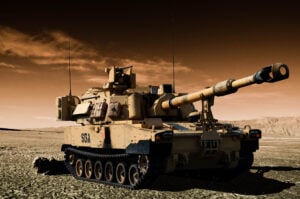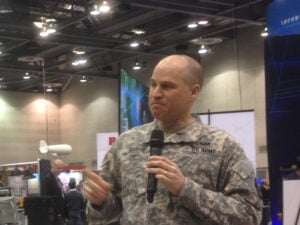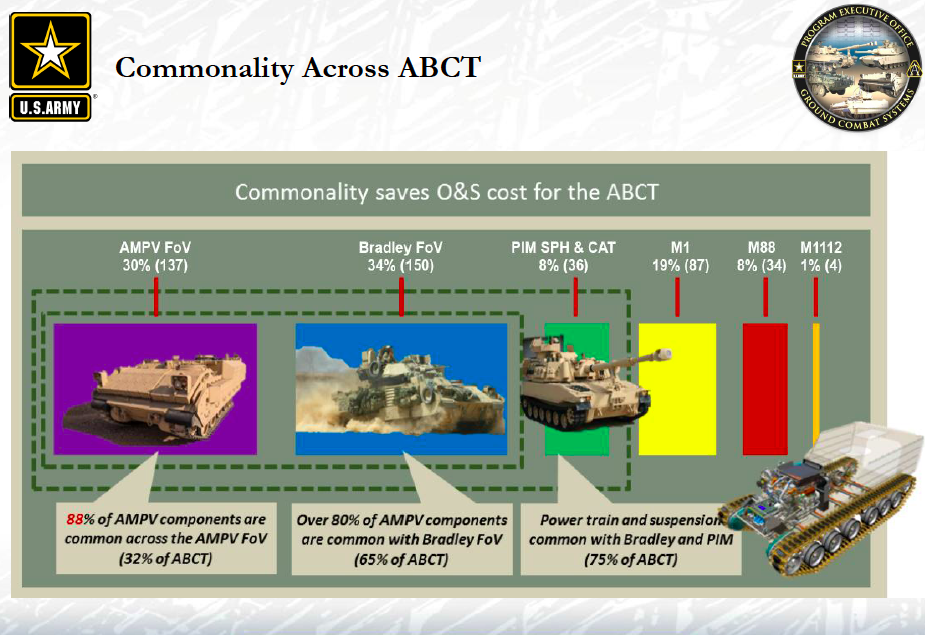Paladin PIM: The Little Cannon That Could & The Future Of The Armored Brigade
Posted on
HUNTSVILLE, ALA.: After 20 years and two costly cancelled programs, the US Army finally has a new artillery vehicle. While the ceremonial rollout isn’t till Thursday, contractor BAE Systems has already delivered the first pair of self-propelled howitzers. Oft-overlooked and blandly named, this Paladin Integrated Management program is a modest but much-needed success for the beleaguered Army acquisition system.
“So far, it has moved along without drama or significant problems,” one Hill staffer told me. “It is not a truly new vehicle in that it borrows from others, but still a success.”
Small though it may seem from the Hill, PIM is a harbinger of three bigger things to come:

M109A7 Paladin PIM self-propelled howitzer
- a revival of the field artillery, the “king of battle” against conventional threats but a neglected “dead branch walking” during counterinsurgency in Afghanistan and Iraq;
- an overhaul of the armored brigade, which will lead to 72 percent of the brigade’s heavy vehicles having the same BAE-built automotive systems;
- a new approach to acquisition, in which expensive, ambitious, all-new designs give way to incremental but still substantial changes to existing platforms.
At first glance, PIM looks like just the latest upgrade to the 1960s-vintage M109 howitzer, from the current M109A6 to PIM’s M109A7. In fact, PIM is more like surgically transplanting someone’s head onto a new body: It takes the old gun turret and installs it on an all-new chassis. What’s more, since earlier upgrade programs rebuilt the turret, the PIM has basically nothing in common with the original Vietnam-era M109 except the name.
“M109A6 built a new turret and put it on the old chassis,” said Mark Signorelli, head of combat vehicle programs at BAE Systems. “M109A7 put a new chassis under the A6 turret, with a few upgrades to the turret, and effectively in two steps the Army built a new howitzer.”
Signorelli is a veteran of the cancelled Future Combat Systems and Ground Combat Vehicle programs, which attempted to develop entirely new designs. “When you have one of these big bang programs…it’s hugely expensive, it takes forever, and it’s risky,” he told me at last week’s Association of the US Army conference in Huntsville. “When you do this Lincoln’s axe approach, you can…put the modernization in bite-size packages, so you’ve got a high probability that you can get the work done on schedule, on budget.”
The result is less radical than a bottom-up new design but definitely more than a mere upgrade. PIM doesn’t have the longer-ranged cannon developed for the cancelled Crusader or the automated ammo loader from FCS. It does, however, have new automotive and electrical systems. As a result, while the A7 weighs 25 percent more than the A6, it generates 50 percent more horsepower and almost four times as much electrical power.
The 650 horsepower engine makes PIM much more maneuverable than the current Paladin model, which is notorious for falling behind other armored vehicles. PIM’s 70 kilowatt generator not only accommodates the latest electronics, from communications networks to defensive jammers: It also allows the replacement of the turret’s leaky, maintenance-intensive hydraulics with modern electric motors. (This “electric drive” technology was actually salvaged from the cancelled FCS program). With a new engine, new transmission, and a hydraulics-free turret, the Paladin PIM should also be much more reliable than the decades-old equipment it replaces.
The Paladin PIM will actually be more modern than the mainstay of the armored brigade, the heavily armed M2 Bradley troop carrier. The new Paladin PIM chassis is “derived from the Bradley chassis, [but] actually somewhat more advanced in many ways in terms of electrical power and other things,” said Brig. Gen. David Bassett, the Army’s program executive officer for ground combat systems, in an interview at AUSA. “It’s the leading vehicle in terms of technology for where we’d like to take the Bradley family of systems.”

Brig. Gen. David Bassett
So Bassett is also overseeing an overhaul of the Bradley. Bradley Engineering Change Proposal 1, already in production, raises the suspension to give seven inches more ground clearance, which improves both cross-country performance and defense against mines exploding from underneath. The far more extensive ECP-2 will replace the Bradley’s entire engine and transmission with the ones pioneered by Paladin, a 12 percent increase in horsepower. ECP-2 will also more than double the Bradley’s electrical power, from nine kilowatts — which is not enough to run anti-IED jammers without turning other electronics off — to 24.
That’s not the 70 kilowatts of Paladin PIM, but it’s plenty, Bassett told me: “We used to power whole TOCs [command posts] with that much power,” he said. “We could’ve taken the PIM power solution and put it on Bradley, but again we’re making hard cost trades” to stay under tight budgets.
“The 70 kw that we see on Paladin [PIM] is probably a practical limit” for the Bradley chassis, Bassett said, “[but] I would struggle to find claimants for 70 kw of power,” anyway.
The last and biggest piece of the modernization effort will be the Armored Multi-Purpose Vehicle. AMPV is a lightly armed but well-armored support vehicle to replace the vulnerable Vietnam-vintage M113. It will use the same automotive systems as the Paladin PIM and Bradley ECP-2. It will also have a new hull, based on the Bradley’s but redesigned for maximum protection against roadside bombs.
AMPV is the Army’s largest modernization program left after the most recent round of cuts, and given budget constraints, the Army can only modernize about 1.3 brigades a year. But once a brigade gets all three upgrades — Paladin PIM, Bradley ECP-2, and AMPV — 72 percent of its armored vehicles will be using the same modernized propulsion system, improving mobility and easing maintenance. Only the M1 Abrams tanks — with their infamously fast and fuel-hungry turbine engines — and a small number of specialist vehicles will require unique spare parts and maintainer training. The added electric power will also ease future upgrades with new networks, sensors, and jammers. It’s a far cry from the comprehensive family of hybrid-electric vehicles envisioned by FCS, but it’s also something the Army can actually achieve.
As the lead vehicle in this slow-but-steady modernization drive, the Paladin PIM isn’t without problems. Some on the Hill though the Army’s acquisition strategy unnecessarily slow, while the Pentagon’s independent tester criticized the accuracy of the prototype cannons — and the program has yet to face full-up operational testing. “That is the graduation event,” the Hill staffer told me.
That staffer’s awareness of Paladin is fairly unusual, said industry analyst and consultant Loren Thompson. “Few members of Congress are conversant with Paladin, which is sad considering how positively it displays the Army’s ability to manage complex technology projects,” Thompson told me. “Paladin is shaping up as a success story for the Army….The Army needs more money to modernize, but Paladin proves significant improvements can be made with relatively modest investments.”
An artillery piece like Paladin may seem archaic in an era of smart bombs and armed drones, when the Air Force is developing a new stealth bomber, the Navy is testing a laser in the Persian Gulf, and the Army itself is considering creating cruise missile batteries. Indeed, US troops in Afghanistan and Iraq relied less on artillery than airstrikes and attack helicopters. But that reliance presumed the aircraft could get through. Against a high-tech foe, one with sophisticated surface-to-air missiles and jamming to drive off American aircraft or decoy their weapons, old-fashioned cannon might be the only big guns a ground commander could rely on.
The Army will get its first full battalion of PIM Paladins — 18 howitzers and 18 armored ammunition carriers — when the program reaches Initial Operational Capability in April 2017. With Army analysts saying potential adversaries already outmatch US artillery, and Russia proving the effectiveness of traditional bombardment on Ukrainian bodies, 2017 is none too soon.

Armored Brigade Combat Team modernization plan
Subscribe to our newsletter
Promotions, new products and sales. Directly to your inbox.
